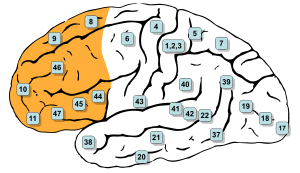Prefrontal Cortex: Difference between revisions
No edit summary |
|||
| Line 30: | Line 30: | ||
[[FFR during Sleep State and Brain Wave Sovereignty]] | [[FFR during Sleep State and Brain Wave Sovereignty]] | ||
[[Wernicke's Area]] | |||
[[Hippocampus]] | [[Hippocampus]] | ||
[[Emotional Self-Regulation]] | [[Emotional Self-Regulation]] | ||
Latest revision as of 00:41, 20 June 2024

In mammalian brain anatomy, the Prefrontal Cortex (PFC) covers the front part of the frontal lobe of the cerebral cortex. It is the association cortex in the frontal lobe. The PFC contains the Brodmann areas BA8, BA9, BA10, BA11, BA12, BA13, BA14, BA24, BA25, BA32, BA44, BA45, BA46, and BA47.
This brain region is involved in a wide range of higher-order cognitive functions, including speech formation (Broca's Area), gaze (frontal eye fields), working memory (dorsolateral prefrontal cortex), and risk processing (e.g. ventromedial prefrontal cortex). The basic activity of this brain region is considered to be orchestration of thoughts and actions in accordance with internal goals. Many authors have indicated an integral link between a person's will to live, personality, and the functions of the prefrontal cortex.
This brain region has been implicated in executive functions, such as planning, decision making, working memory, personality expression, moderating social behavior and controlling certain aspects of speech and language. Executive function relates to abilities to differentiate among conflicting thoughts, determine good and bad, better and best, same and different, future consequences of current activities, working toward a defined goal, prediction of outcomes, expectation based on actions, and social "control" (the ability to suppress urges that, if not suppressed, could lead to socially unacceptable outcomes).
The frontal cortex supports concrete rule learning, with more anterior regions supporting rule learning at higher levels of abstraction.
Interconnections
The prefrontal cortex is highly interconnected with much of the brain, including extensive connections with other cortical, subcortical and brain stem sites. The dorsal prefrontal cortex is especially interconnected with brain regions involved with attention, cognition and action, while the ventral prefrontal cortex interconnects with brain regions involved with emotion. The prefrontal cortex also receives inputs from the brainstem arousal systems, and its function is particularly dependent on its neurochemical environment.[2]
Broca Area Speech Production

Broca's area, or the Broca area, is a region in the frontal lobe of the dominant hemisphere, usually the left, of the brain with functions linked to speech production.
Language processing has been linked to Broca's area since Pierre Paul Broca reported impairments in two patients. They had lost the ability to speak after injury to the posterior inferior frontal gyrus (pars triangularis) (BA45) of the brain. Since then, the approximate region he identified has become known as Broca's area, and the deficit in language production as Broca's aphasia, also called expressive aphasia. Broca's area is now typically defined in terms of the pars opercularis and pars triangularis of the inferior frontal gyrus, represented in Brodmann's cytoarchitectonic map as Brodmann area 44 and Brodmann area 45 of the dominant hemisphere.
Functional magnetic resonance imaging (fMRI) has shown language processing to also involve the third part of the inferior frontal gyrus the pars orbitalis, as well as the ventral part of BA6 and these are now often included in a larger area called Broca's region.
Studies of chronic aphasia have implicated an essential role of Broca's area in various speech and language functions. Further, fMRI studies have also identified activation patterns in Broca's area associated with various language tasks. However, slow destruction of Broca's area by brain tumors can leave speech relatively intact, suggesting its functions can shift to nearby areas in the brain.

